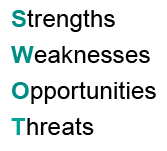Used by marketers to evaluate themselves and the environment in which they work, the SWOT analysis is a cornerstone of most marketing strategies. However, recent news reports suggesting customers are losing trust in some of the biggest brands, points to a disconnect between what customers want and what brands are offering in terms of service and satisfaction. Do marketers look closely enough at the customer element of the SWOT, and if they were to ask customers to conduct a similar analysis, would their results match what their internal experts concluded?
One of the biggest challenges is understanding what your customers actually think of your brand, service and your products – essential input required for SWOT analysis. Organisations often rely on market research, focus groups, and anecdotal evidence from around the company. But these approaches aren’t without their flaws: first, they’re expensive and time consuming. Second, one can’t really guarantee they really capture the essence of what your customers are saying.
There is another approach, one which is based on gathering live insights into what customers say every day – to call centre agents, in emails, even on social media. The brief asides and comments customers make every day are all pieces of a jigsaw which, when assembled, can clearly map out what customers really think. Feeding this customer insight into marketing strategies and future campaigns means brands can better cater to the desires, needs and perceptions of customers.
A Real-World Scenario
A leading global telecom provider recently put this concept to the test. As a first step, the organisation collected “voice of the customer” (VOC) inputs from internal and external sources, such as recorded customer calls, free form call centre agent notes, email, chat, and SMS. Additionally, the company mined social media sites like Twitter and key telecoms related web sites.
The company evaluated the data with a voice of the customer analytics platform – including speech analytics for mining the unstructured voice calls and text analytics for mining the unstructured text interactions. At first glance, the telecom provider discovered the top issues that were being discussed by customers, including issues such as iPhone, international usage and coverage. Taking this a step further, it took each of these topics and conducted a sentiment analysis using natural language processing (NLP). NLP is an important technology that allows the breakdown of text comments from customers, and understands the positive and negative sentiments noted within. The customer may post a note such as, “Love the intuitive large touch-screen of my new phone, but the battery life is not great.” NLP automatically extracts the positive sentiment regarding the screen and the negative sentiment regarding the battery.
This same telecom provider compared the volume and associated sentiment of comments when its brand was mentioned and compared with competitors. The results were used to create a SWOT analysis based on the voice of the customer. The discovery was quite eye-opening! What you may consider as key strengths may not always be what customers are even talking about or discussing about in the market. The viral effect of social media can significantly increase or decrease the impact of your existing strengths and weaknesses across the industry. With this VOC customer SWOT approach, the company’s marketing team can incorporate valuable changes into planned outreach campaigns and programmes. It is usually easier to emphasise strengths that are already being recognised by current customers publicly, or take advantage of perceived weaknesses of your competitors.
The organisation also analysed the many customer suggestions posted online via public and social websites, as well as interactions conducted directly with the company’s contact centre. Many of these had significant opportunities that could translate into considerable cost savings, all while increasing customer satisfaction. Customers are not always aware of certain elements of the product and services, and their suggestions can help focus where more awareness is needed. Threats are also a key monitoring point, especially the ones conducted online, as they tend to have more viral appeal. Examples include when a customer warns they will contact their lawyer or Ofcom with a complaint. It is important to monitor these channels effectively to isolate potential customer service issues before they become major threats to their reputation and brand. This can be done via daily alerts, tracking what the industry is saying about the organisation and allowing it to take action immediately and before such topics hit the social domain.
A Challenge to all Marketing Teams
Think about taking your unbiased “voice of the customer” into account when you conduct your next SWOT analysis. Adding customer perspective may incorporate that special touch to turn an average marketing campaign into a raging success. To get started, reach out to external sources such as social media channels, but make sure you also partner with your contact centre. These frontline professionals hear complaints, praises, questions and more each day from your customer base. And, if the capability to mine the data from a technology standpoint is available¾that will catapult your research even further. Your SWOT analysis and campaign programmes will only benefit from these few extra steps to close the loop and cater to the wants needs and perceptions of your customer.






